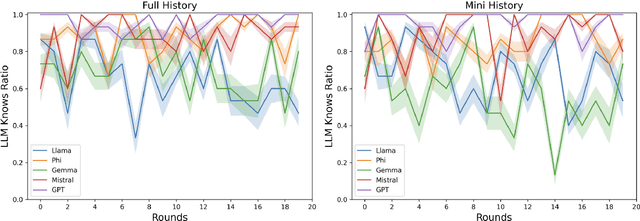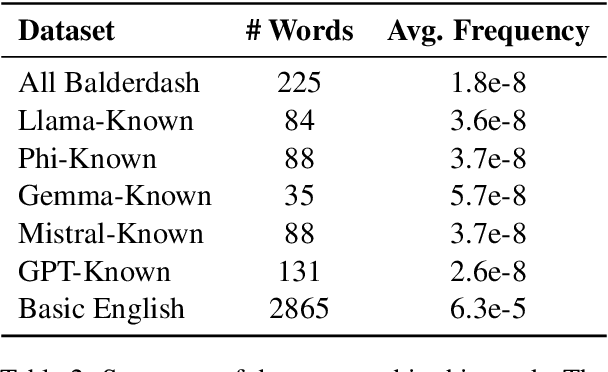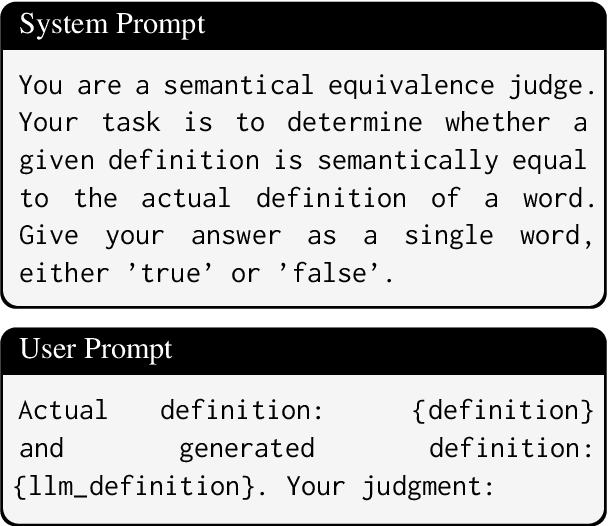Jesse Thomason
University of Southern California
From Calibration to Collaboration: LLM Uncertainty Quantification Should Be More Human-Centered
Jun 09, 2025Abstract:Large Language Models (LLMs) are increasingly assisting users in the real world, yet their reliability remains a concern. Uncertainty quantification (UQ) has been heralded as a tool to enhance human-LLM collaboration by enabling users to know when to trust LLM predictions. We argue that current practices for uncertainty quantification in LLMs are not optimal for developing useful UQ for human users making decisions in real-world tasks. Through an analysis of 40 LLM UQ methods, we identify three prevalent practices hindering the community's progress toward its goal of benefiting downstream users: 1) evaluating on benchmarks with low ecological validity; 2) considering only epistemic uncertainty; and 3) optimizing metrics that are not necessarily indicative of downstream utility. For each issue, we propose concrete user-centric practices and research directions that LLM UQ researchers should consider. Instead of hill-climbing on unrepresentative tasks using imperfect metrics, we argue that the community should adopt a more human-centered approach to LLM uncertainty quantification.
HAND Me the Data: Fast Robot Adaptation via Hand Path Retrieval
May 28, 2025Abstract:We hand the community HAND, a simple and time-efficient method for teaching robots new manipulation tasks through human hand demonstrations. Instead of relying on task-specific robot demonstrations collected via teleoperation, HAND uses easy-to-provide hand demonstrations to retrieve relevant behaviors from task-agnostic robot play data. Using a visual tracking pipeline, HAND extracts the motion of the human hand from the hand demonstration and retrieves robot sub-trajectories in two stages: first filtering by visual similarity, then retrieving trajectories with similar behaviors to the hand. Fine-tuning a policy on the retrieved data enables real-time learning of tasks in under four minutes, without requiring calibrated cameras or detailed hand pose estimation. Experiments also show that HAND outperforms retrieval baselines by over 2x in average task success rates on real robots. Videos can be found at our project website: https://liralab.usc.edu/handretrieval/.
TNG-CLIP:Training-Time Negation Data Generation for Negation Awareness of CLIP
May 24, 2025Abstract:Vision-language models (VLMs), such as CLIP, have demonstrated strong performance across a range of downstream tasks. However, CLIP is still limited in negation understanding: the ability to recognize the absence or exclusion of a concept. Existing methods address the problem by using a large language model (LLM) to generate large-scale data of image captions containing negation for further fine-tuning CLIP. However, these methods are both time- and compute-intensive, and their evaluations are typically restricted to image-text matching tasks. To expand the horizon, we (1) introduce a training-time negation data generation pipeline such that negation captions are generated during the training stage, which only increases 2.5% extra training time, and (2) we propose the first benchmark, Neg-TtoI, for evaluating text-to-image generation models on prompts containing negation, assessing model's ability to produce semantically accurate images. We show that our proposed method, TNG-CLIP, achieves SOTA performance on diverse negation benchmarks of image-to-text matching, text-to-image retrieval, and image generation.
Large Language Models Do Multi-Label Classification Differently
May 23, 2025Abstract:Multi-label classification is prevalent in real-world settings, but the behavior of Large Language Models (LLMs) in this setting is understudied. We investigate how autoregressive LLMs perform multi-label classification, with a focus on subjective tasks, by analyzing the output distributions of the models in each generation step. We find that their predictive behavior reflects the multiple steps in the underlying language modeling required to generate all relevant labels as they tend to suppress all but one label at each step. We further observe that as model scale increases, their token distributions exhibit lower entropy, yet the internal ranking of the labels improves. Finetuning methods such as supervised finetuning and reinforcement learning amplify this phenomenon. To further study this issue, we introduce the task of distribution alignment for multi-label settings: aligning LLM-derived label distributions with empirical distributions estimated from annotator responses in subjective tasks. We propose both zero-shot and supervised methods which improve both alignment and predictive performance over existing approaches.
Zero-Shot Iterative Formalization and Planning in Partially Observable Environments
May 19, 2025Abstract:In planning, using LLMs not to predict plans but to formalize an environment into the Planning Domain Definition Language (PDDL) has been shown to greatly improve performance and control. While most work focused on fully observable environments, we tackle the more realistic and challenging partially observable environments where existing methods are incapacitated by the lack of complete information. We propose PDDLego+, a framework to iteratively formalize, plan, grow, and refine PDDL representations in a zero-shot manner, without needing access to any existing trajectories. On two textual simulated environments, we show that PDDLego+ not only achieves superior performance, but also shows robustness against problem complexity. We also show that the domain knowledge captured after a successful trial is interpretable and benefits future tasks.
ReWiND: Language-Guided Rewards Teach Robot Policies without New Demonstrations
May 16, 2025Abstract:We introduce ReWiND, a framework for learning robot manipulation tasks solely from language instructions without per-task demonstrations. Standard reinforcement learning (RL) and imitation learning methods require expert supervision through human-designed reward functions or demonstrations for every new task. In contrast, ReWiND starts from a small demonstration dataset to learn: (1) a data-efficient, language-conditioned reward function that labels the dataset with rewards, and (2) a language-conditioned policy pre-trained with offline RL using these rewards. Given an unseen task variation, ReWiND fine-tunes the pre-trained policy using the learned reward function, requiring minimal online interaction. We show that ReWiND's reward model generalizes effectively to unseen tasks, outperforming baselines by up to 2.4x in reward generalization and policy alignment metrics. Finally, we demonstrate that ReWiND enables sample-efficient adaptation to new tasks, beating baselines by 2x in simulation and improving real-world pretrained bimanual policies by 5x, taking a step towards scalable, real-world robot learning. See website at https://rewind-reward.github.io/.
Multi-modal Synthetic Data Training and Model Collapse: Insights from VLMs and Diffusion Models
May 10, 2025Abstract:Recent research has highlighted the risk of generative model collapse, where performance progressively degrades when continually trained on self-generated data. However, existing exploration on model collapse is limited to single, unimodal models, limiting our understanding in more realistic scenarios, such as diverse multi-modal AI agents interacting autonomously through synthetic data and continually evolving. We expand the synthetic data training and model collapse study to multi-modal vision-language generative systems, such as vision-language models (VLMs) and text-to-image diffusion models, as well as recursive generate-train loops with multiple models. We find that model collapse, previously observed in single-modality generative models, exhibits distinct characteristics in the multi-modal context, such as improved vision-language alignment and increased variance in VLM image-captioning task. Additionally, we find that general approaches such as increased decoding budgets, greater model diversity, and relabeling with frozen models can effectively mitigate model collapse. Our findings provide initial insights and practical guidelines for reducing the risk of model collapse in self-improving multi-agent AI systems and curating robust multi-modal synthetic datasets.
Adjust for Trust: Mitigating Trust-Induced Inappropriate Reliance on AI Assistance
Feb 18, 2025Abstract:Trust biases how users rely on AI recommendations in AI-assisted decision-making tasks, with low and high levels of trust resulting in increased under- and over-reliance, respectively. We propose that AI assistants should adapt their behavior through trust-adaptive interventions to mitigate such inappropriate reliance. For instance, when user trust is low, providing an explanation can elicit more careful consideration of the assistant's advice by the user. In two decision-making scenarios -- laypeople answering science questions and doctors making medical diagnoses -- we find that providing supporting and counter-explanations during moments of low and high trust, respectively, yields up to 38% reduction in inappropriate reliance and 20% improvement in decision accuracy. We are similarly able to reduce over-reliance by adaptively inserting forced pauses to promote deliberation. Our results highlight how AI adaptation to user trust facilitates appropriate reliance, presenting exciting avenues for improving human-AI collaboration.
Better Slow than Sorry: Introducing Positive Friction for Reliable Dialogue Systems
Jan 31, 2025



Abstract:While theories of discourse and cognitive science have long recognized the value of unhurried pacing, recent dialogue research tends to minimize friction in conversational systems. Yet, frictionless dialogue risks fostering uncritical reliance on AI outputs, which can obscure implicit assumptions and lead to unintended consequences. To meet this challenge, we propose integrating positive friction into conversational AI, which promotes user reflection on goals, critical thinking on system response, and subsequent re-conditioning of AI systems. We hypothesize systems can improve goal alignment, modeling of user mental states, and task success by deliberately slowing down conversations in strategic moments to ask questions, reveal assumptions, or pause. We present an ontology of positive friction and collect expert human annotations on multi-domain and embodied goal-oriented corpora. Experiments on these corpora, along with simulated interactions using state-of-the-art systems, suggest incorporating friction not only fosters accountable decision-making, but also enhances machine understanding of user beliefs and goals, and increases task success rates.
Evaluating Creativity and Deception in Large Language Models: A Simulation Framework for Multi-Agent Balderdash
Nov 15, 2024



Abstract:Large Language Models (LLMs) have shown impressive capabilities in complex tasks and interactive environments, yet their creativity remains underexplored. This paper introduces a simulation framework utilizing the game Balderdash to evaluate both the creativity and logical reasoning of LLMs. In Balderdash, players generate fictitious definitions for obscure terms to deceive others while identifying correct definitions. Our framework enables multiple LLM agents to participate in this game, assessing their ability to produce plausible definitions and strategize based on game rules and history. We implemented a centralized game engine featuring various LLMs as participants and a judge LLM to evaluate semantic equivalence. Through a series of experiments, we analyzed the performance of different LLMs, examining metrics such as True Definition Ratio, Deception Ratio, and Correct Guess Ratio. The results provide insights into the creative and deceptive capabilities of LLMs, highlighting their strengths and areas for improvement. Specifically, the study reveals that infrequent vocabulary in LLMs' input leads to poor reasoning on game rules and historical context (https://github.com/ParsaHejabi/Simulation-Framework-for-Multi-Agent-Balderdash).
 Add to Chrome
Add to Chrome Add to Firefox
Add to Firefox Add to Edge
Add to Edge